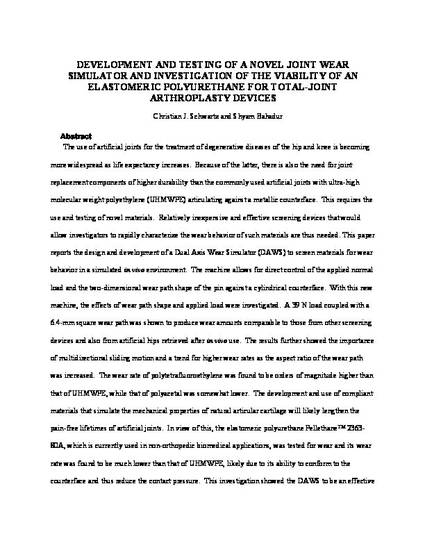
Article
Development and Testing of a Novel Joint Wear Simulator and Investigation of the Viability of an Elastomeric Polyurethane for Total-Joint Arthroplasty Devices
Wear
(2007)
Abstract
The use of artificial joints for the treatment of degenerative diseases of the hip and knee is becoming more widespread as life expectancy increases. Because of the latter, there is also the need for joint replacement components of higher durability than the commonly used artificial joints with ultra-high molecular weight polyethylene (UHMWPE) articulating against a metallic counterface. This requires the use and testing of novel materials. Relatively inexpensive and effective screening devices that would allow investigators to rapidly characterize the wear behavior of such materials are thus needed. This paper reports the design and development of a Dual Axis Wear Simulator (DAWS) to screen materials for wear behavior in a simulated in vivo environment. The machine allows for direct control of the applied normal load and the two-dimensional wear path shape of the pin against a cylindrical counterface. With this new machine, the effects of wear path shape and applied load were investigated. A 39 N load coupled with a 6.4-mm square wear path was shown to produce wear amounts comparable to those from other screening devices and also from artificial hips retrieved after in vivo use. The results further showed the importance of multidirectional sliding motion and a trend for higher wear rates as the aspect ratio of the wear path was increased. The wear rate of polytetrafluoroethylene was found to be orders of magnitude higher than that of UHMWPE, while that of polyacetal was somewhat lower. The development and use of compliant materials that simulate the mechanical properties of natural articular cartilage will likely lengthen the pain-free lifetimes of artificial joints. In view of this, the elastomeric polyurethane Pellethane™ 2363-80A, which is currently used in non-orthopedic biomedical applications, was tested for wear and its wear rate was found to be much lower than that of UHMWPE, likely due to its ability to conform to the counterface and thus reduce the contact pressure. This investigation showed the DAWS to be an effective wear simulator for the screening of new biomaterials for use in artificial joints and will be useful in the development of such joints.
Disciplines
Publication Date
2007
DOI
10.1016/j.wear.2006.05.018
Publisher Statement
Copyright © 2007 Elsevier B.V.
Citation Information
Christian J. Schwartz and Shyam Bahadur. "Development and Testing of a Novel Joint Wear Simulator and Investigation of the Viability of an Elastomeric Polyurethane for Total-Joint Arthroplasty Devices" Wear Vol. 262 (2007) p. 331 - 339 Available at: http://works.bepress.com/christian-schwartz/27/
Creative Commons license

This work is licensed under a Creative Commons CC_BY-NC-ND International License.
